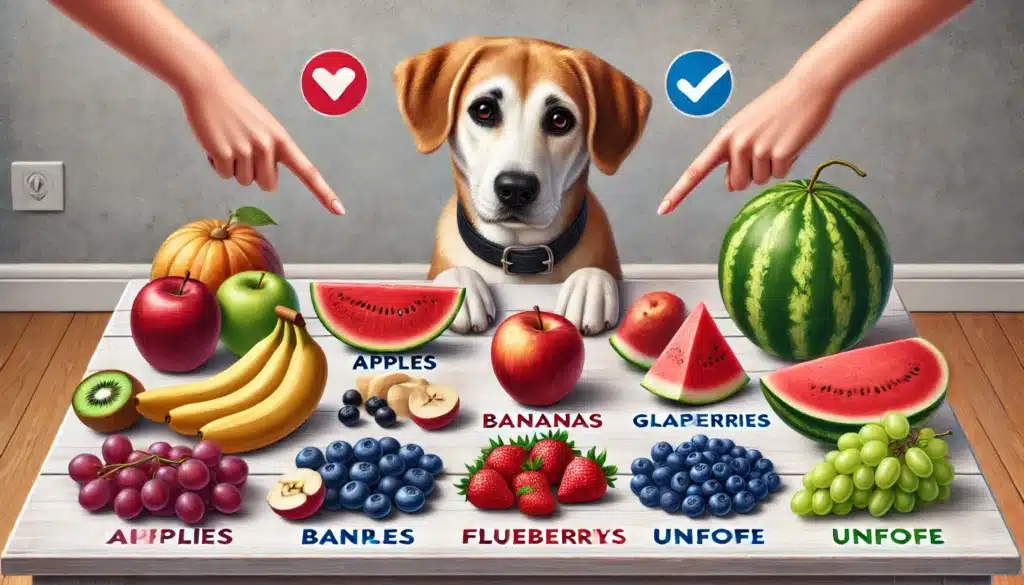Fruits are a healthy, natural snack for humans — but can dogs eat fruit too? The short answer is yes — some fruits are not only safe but beneficial for dogs, while others can be harmful or even toxic.
In this complete guide, we’ll break down which fruits are safe, which are dangerous, how to serve them properly, and what benefits your dog can gain from these colorful treats.
Are Fruits Good for Dogs?
Yes, in moderation. Many fruits provide:
- Vitamins (A, C, K, B-complex)
- Antioxidants (which help fight inflammation)
- Fiber (for digestion)
- Hydration (due to high water content)
- Natural sweetness (a healthier alternative to processed treats)
But too much fruit can cause:
- Upset stomach
- Diarrhea or gas
- Weight gain (from sugar content)
Moderation is key. Fruits should be a supplement, not a major part of your dog’s diet — ideally no more than 10% of daily calories.
✅ Safe Fruits for Dogs
These fruits are safe for dogs when served in small portions and without seeds, pits, or peels.
🍎 Apples
- Rich in vitamins A and C
- High in fiber
- Remove core and seeds (contain cyanide)
🍌 Bananas
- Easy to digest
- Great source of potassium and magnesium
- High in sugar — give occasionally
🍓 Strawberries
- Packed with antioxidants
- Can help whiten teeth naturally
- Cut into small pieces to avoid choking
🍉 Watermelon
- 92% water — excellent for hydration
- Rich in vitamins A, B6, and C
- Remove rind and seeds
🫐 Blueberries
- Superfood packed with antioxidants
- Great for the brain and immune system
- Serve fresh or frozen as a training treat
🍐 Pears
- High in fiber and vitamin C
- Remove seeds and core
- Cut into bite-sized pieces
🍊 Oranges (in moderation)
- Safe but acidic — may upset sensitive stomachs
- Remove peel and seeds
- Offer only a few segments
🍍 Pineapple
- Good source of vitamin C and digestive enzymes
- Remove outer skin and core
- Can be served fresh or frozen
🥭 Mango
- Rich in vitamins and antioxidants
- Remove pit (toxic) and peel
- High in sugar — offer sparingly
🍑 Peaches
- Safe in small quantities
- Remove pit (contains cyanide)
- Avoid canned peaches (often contain added sugars)
❌ Fruits That Are Toxic or Unsafe for Dogs
Even a small amount of these fruits can be dangerous. Avoid them completely:
🍇 Grapes & Raisins
- Extremely toxic
- Can cause kidney failure — even a single grape
🍒 Cherries
- Flesh is safe in small amounts
- Pits, stems, and leaves contain cyanide
- Easy to choke on or swallow whole
🍍 Avocado
- Contains persin, a toxin that can cause vomiting and diarrhea
- Especially dangerous to smaller dogs
🍅 Tomatoes (unripe or green parts)
- Ripe tomato flesh in small amounts is safe
- But green parts contain solanine, which is toxic
🍊 Lemons & Limes
- Highly acidic
- Can cause upset stomach and sensitivity
🍅 Rhubarb
- Contains oxalic acid, which interferes with calcium absorption
- Can lead to kidney failure in large amounts
How to Safely Serve Fruit to Dogs
To avoid problems:
- Always wash fruit thoroughly
- Remove seeds, pits, rinds, and peels
- Cut into small, manageable pieces
- Introduce one fruit at a time
- Monitor for allergic reactions or upset stomach
Tip: Serve fruits chilled or frozen for a refreshing summer treat!
Creative Ways to Use Fruit in Dog Treats
Want to make fruit more fun for your dog? Try:
- Freezing chopped fruit inside ice cubes
- Mixing with plain yogurt for a fruity pup-cup
- Filling a Kong with mashed banana and blueberries
- Blending fruit into frozen treat molds
- Making DIY fruit jerky in a dehydrator (no sugar added)
These options are great for training rewards or cool-down treats.
When to Call the Vet
Seek veterinary help if your dog eats any unsafe fruit — especially grapes or cherries — or shows signs like:
- Vomiting
- Diarrhea
- Weakness or lethargy
- Trembling
- Seizures
- Loss of appetite
When in doubt, call your vet immediately.
Final Thoughts: Sweet Snacks with Smarts
Fruits can be a fun, healthy addition to your dog’s diet — but only if you choose the right ones and serve them the right way. Keep portions small, skip the pits, and always observe your dog’s reaction to new foods.
With a little care and creativity, fruit can become a natural, tasty treat your dog will love — no sugar, no guilt, just tail-wagging goodness.







